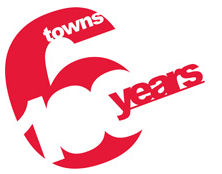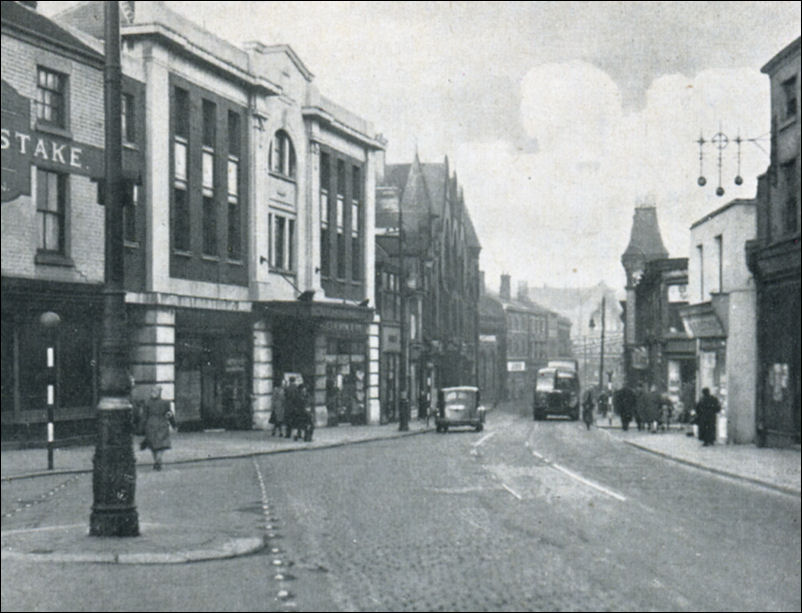![]()
|
|
|
|
|
Stoke-on-Trent - photo of the week |
Advert of the Week
Potworks of the Week
Longton -
Stafford Street (now The Strand)

|
Scenes in the Six Towns "It is natural that to some extent the six towns now federated as the city of Stoke-on-Trent should have their independent lives and local associations existing side by side with their corporate life and wider civic associations. Here then is a short special reference to each Pottery-town." 1947 City of Stoke-on-Trent Official Handbook |

Longton - Stafford
Street c.1947
[now named The Strand]
![]() more
on Methodist Central Hall
more
on Methodist Central Hall
|
|
Longton in 1828 "LANE END, a populous and thriving market-town, and with LONGTON, forms an extensive township, situated five miles south-east of Newcastle,, at the southern extremity of the Potteries, and has risen in a few years by the almost magical influence of a prosperous manufacture to a respectable degree of opulence. The church is similar to that of Hanley, but does not appear to so much advantage, being in a comparatively low situation; it was rebuilt about the year 1795, and is a perpetual curacy, in the gift of trustees. The original chapel was principally built and endowed at the charge of the late J. Bourne, Esq. and was consecrated in 1764; it is a chapel of ease to Stoke. There are also places of worship for the Methodists and other dissenters, and one catholic chapel. An English charity school adjoins the church-yard, which, according to and inscription, was built and endowed in 1760, of which Mr. Bourne is said to have been the founder. Here is also a national school and mechanics' institute. From the great increase of the population here, the commissioners for building churches have considered this place eligible for the erection of a new one, and the ground is taken for that purpose. The canal from Manchester and Liverpool to London passes within two miles of this town, and a small rivulet runs through it, upon which are several flint mills. The market-days are Wednesday and Saturday, the latter is the principle, and is well supplied with provisions of all kinds. The fairs are February 14th, May 29th, July 22nd and November 1st, for woollen cloth, hardware and pedlary. By the parliamentary returns for 1821, the township of Lane End and Longton contained 7,100 inhabitants, but a census taken by the Rev. Mr. Temple, in 1826, the population had increased to 8,500 persons. Pigot & Co's 1828/9 Directory of Staffordshire
Longton in 1907 (3 years before federation) "Longton, which was formerly known as Lane End, lies on the southern extremity of the Potteries, and enjoys this advantage over the sister towns, that it is in immediate touch on the east, south, and west with pretty, open country, the main arteries leading to Trentham, Stone, Uttoxeter, and Leek. Up to 1865 the town was governed by Commissioners, and when in the year mentioned the borough was incorporated it embraced Longton and Edensor. In 1883, the district of East Vale (which is in the ecclesiastical parish of Caverswall) was joined to the borough, followed in 1884 by the annexation of Florence and Dresden, which are separate rating areas. The present borough comprises 1,934- acres, and the estimated population is about 37,000. Longton is frequently referred to as the world's centre of the cheap china trade. The better class of ware is also largely manufactured in the town, as well as earthenware, and the pits of the Florence Coal and Iron Company, Ltd., in which the Duke of Sutherland holds the controlling interest, form the chief colliery undertaking. The North Stafford Railway Company has two stations in the borough, and the main-line service is in direct communication with Derby and Crewe. The Potteries Electric Traction Company has termini on three of the principal roads connecting with the country districts, and an extension of the system to the Meir and Blythe Bridge was sanctioned some years ago. There are seven ecclesiastical parishes in the town. The Parish Church, dedicated to St. James, was erected in 1833. Among the Rectors was the late Dr. Benjamin Vale, whose residence was sacked at the time of the Pottery riots. St. John's Church, built in 1792-5, is still called in ecclesiastical deeds the church of Lane End. There are other Anglican churches at Edensor, Dresden, Normacot, and Sandford Hill, and the Roman Catholics have an imposing edifice which is styled the cathedral of the diocese. Dr. Ilsley, the present Bishop of Birmingham, was at one time priest-in-charge. The Nonconformist communions are largely represented, and the Wesleyan Methodist, New Connexion, Primitive Methodist, and Congregational bodies possess commodious places of worship. Day schools are affiliated with the Parish Church, and the churches of Edensor, Dresden, and Normacot, in addition to which there are seven Council schools, and one erected by the Roman Catholics. In the higher branches of educational work, Longton is also excellently equipped. The High School, now carried on by the local authority, was formerly called the Endowed School, and was mainly supported by the Dilhorne Charity. It is a recognised secondary school, with a large attendance of boy and girl students, and is doing excellent work. Some years ago the school was co-ordinated with the Sutherland Technical Institute and School of Science and Art. This building was secured mainly through the efforts of Aid. Aaron Edwards, J.P., who inaugurated the movement to commemorate his four years' Mayoralty, and who raised nearly £8,000 towards the cost. The foundation stone was laid in January, 1898, by the King, when Prince of Wales; the site was given by the Duke of Sutherland. Thanks to the foresight and the keen local patriotism of its leading inhabitants, Longton has become equipped with many other valuable municipal assets. By personal generosity and active work, the late Mr. John Aynsley secured for the town a splendid pleasure ground, known as the Queen's Park, the site of which was given by the late Duke of Sutherland. It is one of the prettiest recreation grounds in the kingdom, and each Whitsuntide it is the scene of attractive fetes promoted by the Town Council for the pleasure of the people and the relief of the rates. The Cottage Hospital, situate at Normacot, is another admirable institution, acquired through the instrumentality of the late Mr. Aynsley and the late Rev Adam Clarke. The Town Council possess a capital gas undertaking which for some years has paid from £2,000 to £2,500 out of the profits to the borough fund; also an electricity station, Town Hall and extensive covered market, a fine set of public and private baths, a splendidly-equipped Public Library, a refuse destructor, cemetery, &c, -while a sewage disposal scheme to cost about £30,000 is being carried out. The water supply of the town is from the reservoirs of the Potteries Waterworks Company. The A company of the 1st Volunteer Battalion of the North Staffordshire Regiment was raised in Longton, and has a small armoury and drill hall which was once a theatre. The present Thespian temple is called Queen's Theatre, a popular and attractive place of amusement which is visited weekly by travelling companies. The town is well supplied with shop property, -and the Town authorities have recently purchased a site near the Town Hall for a new post office. Longton is within the Stoke Poor Law Union, and is policed by the Staffordshire County Constabulary. There is a borough magistracy. The English China Manufacturers' Association is the chief trade institution. The chief fair during the year occurs at Shrovetide, when a large aggregation of " wakes" attractions is pitched on an open space near the railway station known as the fair ground."
1907 Staffordshire Sentinel 'Business Reference Guide to The Potteries, Newcastle & District'
|